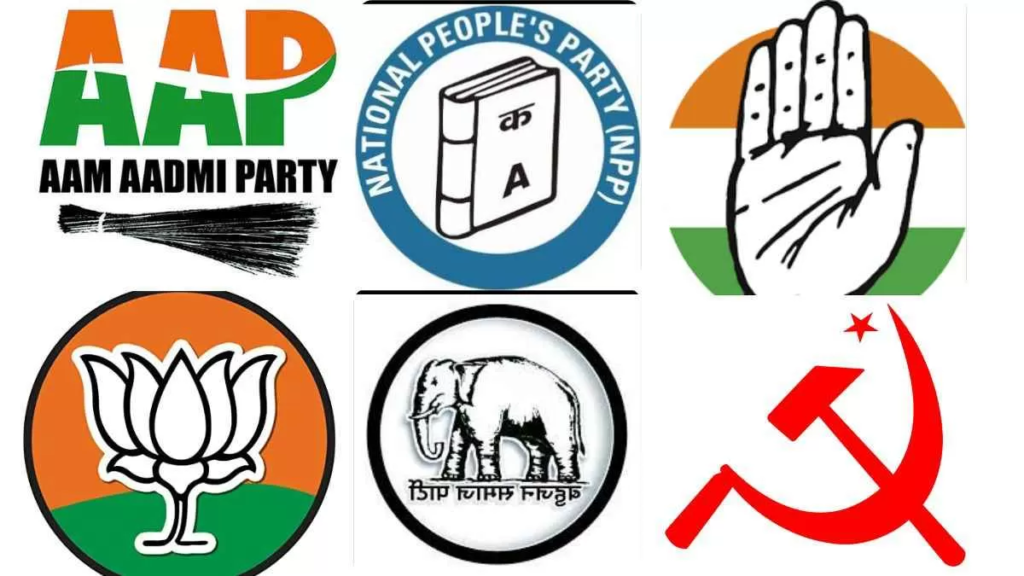Political parties are the backbone of any democratic system, shaping the political landscape, influencing policies, and representing diverse interests within a society. For aspirants preparing for the Union Public Service Commission (UPSC) exams, understanding the intricacies of political parties is not just essential but imperative.

In India, the Party System signifies a multi-party framework where numerous political entities engage in democratic competition for governance. These parties are structured organizations and voluntary coalitions of individuals sharing common political beliefs, aiming to acquire power and govern the nation through constitutional channels, all while advocating for national interests. The Election Commission of India acknowledges various political parties operating at both national and state levels, provided they fulfill specific criteria during general elections for the State Legislative Assembly or Lok Sabha.
Type of Political Parties
Political parties are organized collectives or voluntary groups of individuals who share similar political perspectives. Their primary objective is to attain power through constitutional means, with the intention of influencing and advancing national interests.
In modern democratic societies, there exist four distinct types of political parties:
- Radical parties: These parties seek to establish a new societal order by replacing existing institutions.
- Liberal parties: They aim to reform and improve existing institutions.
- Conservative parties: These parties advocate for maintaining the current status quo.
- Reactionary parties: They are inclined towards preserving existing political and socio-economic structures.
In the Indian context, political parties are categorized based on their ideologies as follows:
- Right-leaning parties, encompassing conservative and reactionary ideologies, such as the BJP.
- Centre-leaning parties, reflecting liberal ideologies, exemplified by the Congress party.
- Left-leaning parties, representing radical ideologies, including the CPI and CPM.
Features of the party system
- Multi-party System: India has many political parties, divided into right, centrist, and left categories. It often leads to coalition governments and situations where no single party has a clear majority.
- Lack of Clear Ideology: Except for a few parties like BJP, CPM, and CPI, most lack a clear ideology. They often share similar views on policies like socialism, secularism, democracy, and Gandhism.
- One-dominant Party Systems: For a long time after independence, one party, mainly the Congress, dominated Indian politics. This led to the term “Congress System” or “one-party dominance system.”
- Personality Cult: Parties in India are often associated with their leaders’ ideologies rather than their manifestos. For instance, Congress gained popularity due to leaders like Nehru and Gandhi.
- Based on Traditional Factors: Many parties formed based on political and socio-economic programs, while others emerged from cultural, linguistic, caste, or religious factors. Examples include the Hindu Maha Sabha, Muslim League, and Shiv Sena.
- Emergence of Regional Parties: Regional parties have become prominent, representing specific states or regions, such as Akali Dal in Punjab, AIADMK in Tamil Nadu, and BJD in Orissa.
- Lack of Effective Opposition: Despite being a democracy, India struggles with an effective opposition. A strong opposition is crucial to check the ruling party’s actions and provide an alternative government, which is currently lacking in India.
What is a National Party
An organization referred to as a national party operates on a nationwide scale, contrasting with regional parties confined to specific states or regions. While being labeled a national party may imply a certain level of prestige, it doesn’t always guarantee significant national political influence.
Criteria for Designation as a National Party:
According to the Election Commission of India’s Political Parties and Election Symbols handbook (2019), a political entity qualifies as a national party if it meets one of the following conditions:
- Recognition in four or more states.
- Securing a minimum of 6% of total valid votes in at least four states during the latest Lok Sabha or Assembly elections, alongside having at least four Members of Parliament from the last Lok Sabha polls.
- Winning at least 2% of total Lok Sabha seats from a minimum of three states.
What is a State Party
A party earns recognition as a state party within a state if it meets any of the following conditions:
- Obtaining 6% of the valid votes cast in a general election for the respective State Legislative Assembly (SLA) and securing at least 2 seats in that assembly.
- Securing 6% of the total valid votes in the state during a general election to the Lok Sabha (LS) and winning at least 1 seat in the LS from the same state.
- Winning either 3% of the seats in the State Legislative Assembly or at least 3 seats in that assembly, whichever is higher, during a general election to the state assembly.
- Securing 1 seat in the Lok Sabha for every 25 seats or fraction thereof allocated to the state during a general election to the LS.
- Obtaining 8% of the total valid votes cast in the state during a general election to the LS or the SLA.
Significance of recognised party
A recognized party, whether at the national or state level, enjoys certain privileges, including the allocation of party symbols, the provision of airtime for political broadcasts on state-owned television and radio stations, and access to electoral rolls. During elections, these parties are permitted to have 40 “star campaigners,” whereas registered but unrecognized parties are limited to 20 “star campaigners.”
Each national party is granted a symbol reserved solely for its use across the country, even in states where it’s not participating in elections. Similarly, a state party receives a symbol exclusively reserved for its use in the state(s) where it holds recognition.
Also read about Special Provision for certain classes.
